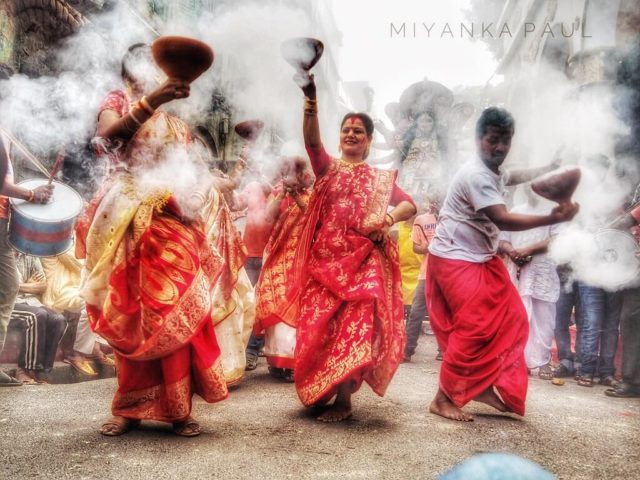Durga Puja has just gotten over but it seems the festive haze has still not lifted up. Having gone to my first ever Durga Puja pandal I was mesmerised by all the hustle and bustle there.
The grand Durga idol and how each pandal had something different to it really impressed me. However, one drawback was that I couldn’t witness the dance that I’ve often seen in movies and images around Durga Puja.
It was this one:

This dance where Bengali women are dancing while holding this curved earthen pot with fragrant smoke billowing from it is called ‘dhunuchi dance.’
What Is Dhunuchi Dance?
Often performed during the main Durga aarti, Dhunuchi naach (dance) is one where the dancer holds a dhunuchi which has burning coconut husk with a bit of dhuno sprinkled on it.
While it might seem as if it’s nothing much, it is actually quite a difficult dance to perform since there is some risk of getting burnt by the burning coconut husk.
The Dhunuchi is an incense burner from Bengal made of clay. For the dance it is filled with broken pieces of coconut husk that are lit by placing burning coal at the bottom and then topped with dhuno (a plant resin with incense properties) and camphor.
The shape of the earthenware with its relatively thick stem and flared head helps to dance with it. All the ingredients are placed inside the head and the stem is held by the dancers in their bare hands.
The common way of dancing with them is to just hold one in each hand and perform the movements that way. However, many people have gone a step further and danced with 3 dhunuchi where one is placed on their chin or they hold it in their mouth.
These days many pandal organisers hold dhunuchi dance competitions that work to attract large amount of crowds.

Read More: Bengali Family To Worship A Muslim Girl As Kumari On Durgashtami
What Does It Mean?
The dance is a way for people to offer their thanks and respect to Goddess Durga. The ‘dhuno’ used in the dhunuchi works as a purifier and allows worshippers to present fragrant and pure air to their Goddess.
It should also be noted that the ‘dhuno’ acts as a natural mosquito repellent. The camphor further adds to create a fragrant smoke that creates a surrealistic atmosphere when such a dance is happening.
The fear of burning coal and coconut husk falling on the hands or feet if they accidentally step on it only further drives worshippers to do it.
Earlier this dance used to be solely performed by men, but in today’s time women also participate in large numbers. In fact people of all ages from old women to young boys and kids participate in it.
Image Credits: Google Images
Sources: Wikipedia, The Statesman
Find the blogger @chirali_08



































